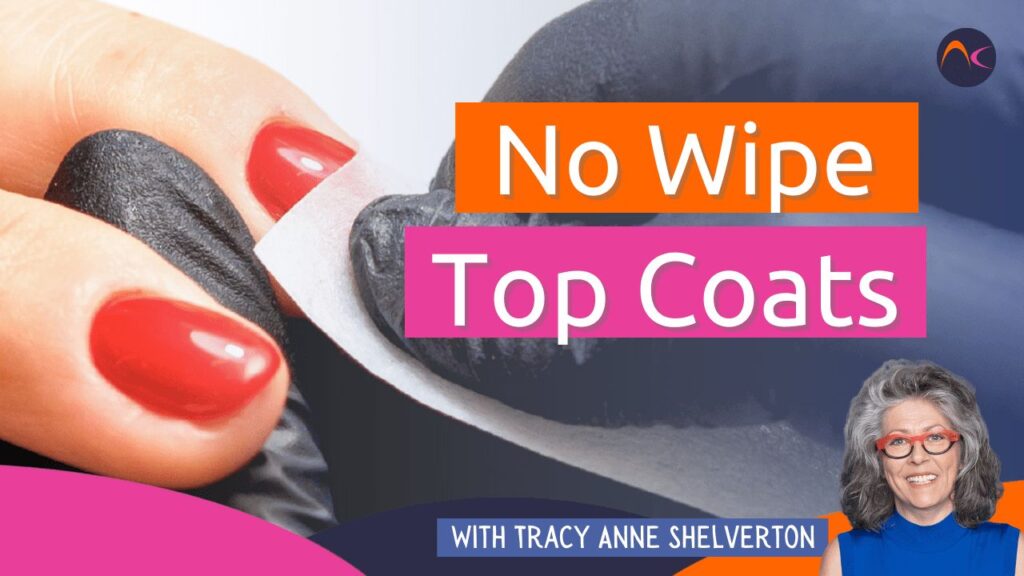In August 2021, the Journal of Allergy and Clinical Immunology published a new research, showing that we have a new problem in the nail industry. And this one we did not see coming: It’s about the NO WIPE TOP COATS– irrespective of brand.
No Wipe Top Coats are amazing for rubbing in our pigment layers. I mean, who doesn’t love a chrome finish?
Nhưng vẫn còn một điều nữa mà không ai trong chúng ta chú ý tới:
1: These No Wipe Top Coats (still) have a sticky layer after curing (and this really does make sense).
2: We must remove the sticky layer of our No Wipe Top Coats with 70% alcohol, or with our favorite nail product cleanser, avoiding contact with the skin. Then, allow our client to wash their hands with soap and water, rinsing well. Follow that with our high-quality oil and lotion.
Làm sao điều này có thể xảy ra? Và tại sao chúng ta chỉ mới nghe về điều này bây giờ?
Thành thật mà nói, chỉ đến bây giờ chúng ta mới nhận ra điều đó.
We already know that in the last year there has been a real problem with clients, customers, hobby techs, and even some real nail professionals showing signs of developed and diagnosed allergies.
We taught all of you that using hand & nail care products, like good quality lotions and oils, is really important. And almost all of you took that advice to heart, not only for your lady clients but your men clients too! You know they are good not only for the nails and the skin, but also to maintain all coatings. You all do it really well. Most quality hand & nail care products have ingredients that promote absorption into the skin, or small enough molecules to penetrate the nail plate. And that’s great! BUT if we don’t cleanse the sticky layer after we have cured our No Wipe Top Coat, then we just smear that, along with the oil, all over our clients’ nails, fingers, and hands, as well as on our own!
Tôi đã hỏi Doug Schoon & Vitaly Solomonoff về ý kiến của họ. Ngoài ra, tôi còn hỏi liệu rửa tay bằng xà phòng và nước có đủ để loại bỏ lớp cặn rất mỏng này không. Sau đây là những gì họ chia sẻ:
Doug Schoon:
Coming in contact with the sticky layer can cause allergies. That is well-known. I think what isn’t appreciated is that, to make a No Wipe Top Coat, many use acrylates because they cure faster and harder than methacrylates. But acrylates are more likely to cause allergies than methacrylates. I think that is the bigger issue. And, if they (nail techs) don’t wear gloves, the solvents can combine with the uncured ingredients to carry them into the skin. Also, it’s not a dispersion layer, this is an oxygen inhibition layer. Oxygen has inhibited the cure at the surface and left lots of uncured ingredients behind. Washing alone may not be enough. Ideally, you’d want to:
-lau sạch lớp
- rửa sạch và lau khô tay
- bôi dầu dưỡng móng tay
Vitaly Solomonoff:
I guess, that the gels with no sticky residue could be washed (I mean the hands) with soap. But a sort of liquid soap, not a regular one should be used – the liquid soap will ensure that the inhibition layer will be removed. It can be achieved with very thorough washing during 2-3 minutes. Some types of inhibition layers are difficult to remove, even with professional detergents, and some residue is spreading over the skin surface. That is why I would prefer wiping the gel nails away with an alcoholic solution before washing hands. Both ways are acceptable, but wiping with alcohol is preferable and safer. It is also important to note that the nail pro should wash their hands, too. So, the best algorithm would be:
- Làm khô lớp sơn phủ không cần lau
- Lau bằng dung dịch cồn
- Rửa tay bằng xà phòng (bất kỳ loại xà phòng nào ở đây)
- Thoa dầu hoặc kem dưỡng da hoặc cả hai ở bước cuối cùng của dịch vụ.
Bạn có thể làm sạch lớp sơn phủ No Wipe bằng (một lượng nhỏ) cồn 70% hoặc sản phẩm làm sạch móng tay yêu thích của bạn.
Tóm lại: Chúng ta thực sự phải LAU LỚP SƠN KHÔNG CẦN LAU!
Then advise our clients to wash their hands with soap and water after we have completed the service. Finish with high-quality nail oil and hand lotion.


